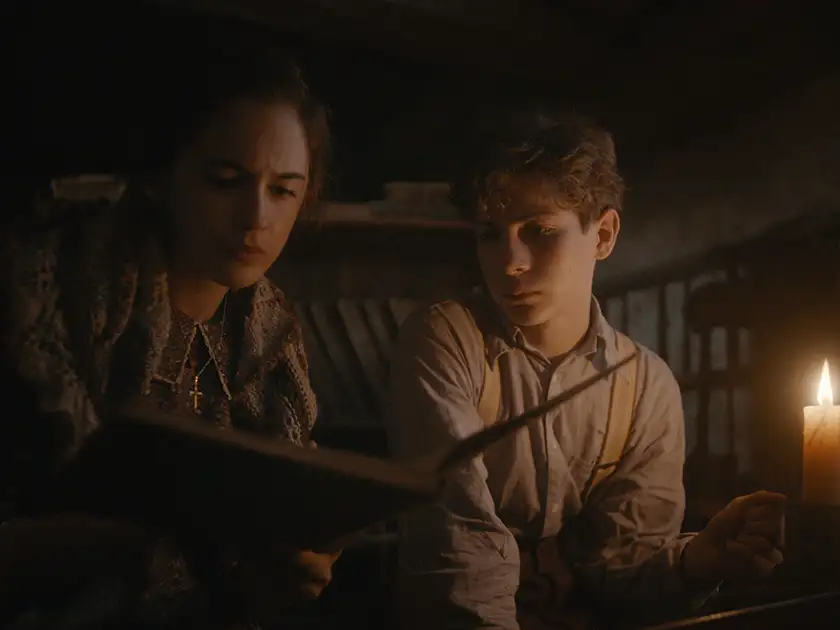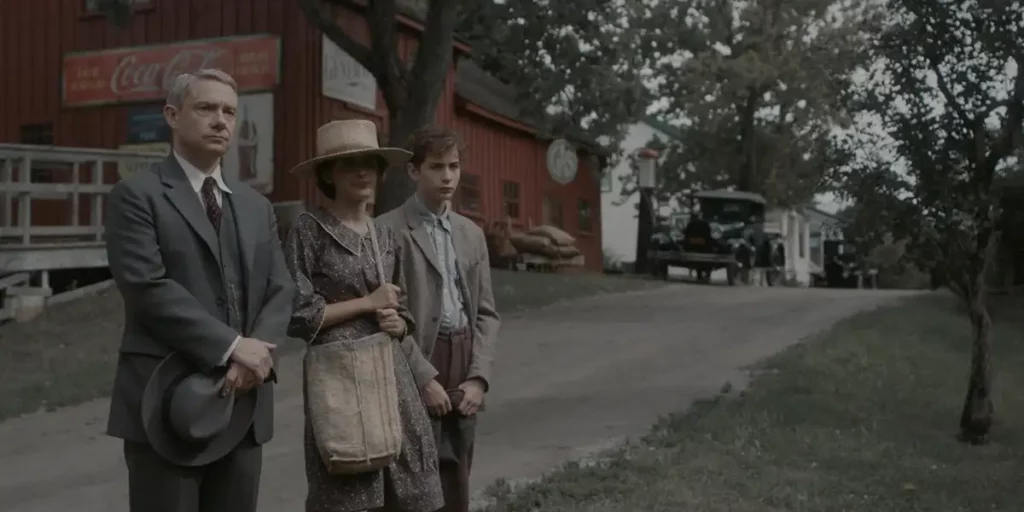Robert Budreau’s Queen of Bones is an average folk horror that fails to capitalise on the haunting promise of its opening scenes.
Queen of Bones, Canadian director Robert Budreau’s new horror-thriller, features tropes that will be all too familiar to fans of The Wicker Man and other folk horror films. Budreau’s supernatural horror story, set in 1930s Depression-era America, features loss, death, and occult possession. The meticulously imagined period setting in rural Oregon sets the film apart from some clichéd folk horrors that rely on surface-level jump scares. However, memorably spooky visuals are not enough to sustain Queen of Bones‘ unwieldy plot and unsatisfying character arcs.
The story opens in 1930s Oregon, US, and follows a hard-up family in a town enduring the rippling effects of the economic downturn. Budreau subtitles his film ‘Folk Tales of the Great Depression’ and makes a great effort to evoke this austere historical period. Martin Freeman plays straitlaced patriarch Malcolm Brass, who has two twin children, Lily (Julie Butters) and Sam Brass (Jacob Tremblay). He ekes out a quiet living as a craftsman repairing violins. This family in Queen of Bones are still haunted by the loss of the twins’ mother. Every birthday, Brass recalls her sacrifice and reminds his children, in graphic detail, of the blood-filled and fatal labour that brought them into the world.
Ironically, Queen of Bones is at its best in these opening scenes, when it is more of a domestic drama than a horror film. These early sequences convey the claustrophobia of its isolated rural setting. Freeman’s depiction of the soft-spoken Malcolm Brass conveys an individual torn between anger and grief. I was also excited to see Julie Butters back on-screen after her small, if vividly memorable, role in Once Upon a Time in Hollywood. Butters‘ performance as Lily emphasises her character’s adolescent angst without undermining her vulnerability.
Yet Queen of Bones begins to lose its way soon after these opening scenes. When Lily gets her first period, she begins to develop new psychic powers that unleash disorder and chaos in the household. The death of Lily’s and Sam’s grandfather, her mother’s father, unravels closely guarded secrets about their mother’s occult past and powers that she may have passed onto her daughter. The darkness fully descends when Malcolm arranges for Lily to be enrolled in a convent school to squash out her rebellion.

This premise has faint echoes of Brian De Palma’s Carrie. Yet Carrie, and other good films of this ilk, often link psychic powers to questions of women’s autonomy and personhood. Queen of Bones does not follow this example or delve into this territory. Instead, Budreau draws in irrelevant plot points that, while attuned to the historical context, only distract from the central horror in the film. The script is peppered with allusions to the Great Depression. President Herbert Hoover intones doom on the family’s wireless set. Lily and Sam are also drawn into an alcohol bootlegging scheme in the film’s latter half. The period setting could have been a main strength of Queen of Bones, but these distracting subplots diffuse the suspense of early scenes.
In its final half, Queen of Bones becomes a disjointed story full of puzzle segments that never seem to fit together. The film gallops at a pace through different phases, toying with recognisable tropes of horror cinema that range from folk elements to feminist horror. Yet, these tropes are not explored in substantial depth. Lily’s psychic powers become another plot point lost amidst a set of disjointed fragments that Budreau cannot pull together in any cathartic way by the film’s conclusion.
Queen of Bones does get points for its well-researched location in rural Oregon. The understated palette of Andre Pienaar’s cinematography adds to its early poignancy and is worthy of description in a John Steinbeck novel. Budreau’s depiction of rural Oregon is not a stark Puritan wilderness in the style of more recent folk horrors like Robert Eggers‘ The Witch. Instead, Queen of Bones depicts a more subtle and textured landscape with shady interiors and dusty green fields that convey the melancholy world of Depression-era Oregon. This landscape serves as a timely reminder that the raw elements of folk horror – the pastoral, the primal, the psychological – can still fuel imaginative new landscapes in horror cinema.
However, Queen of Bones is still a decidedly mixed bag, with early moments of poignancy undermined by a stilted script and overambitious plot. It’s a horror film that somehow fails to execute obvious moments of tension and horror. If you’re looking for a more memorable and incisive type of horror film, there are other contemporary folk horrors you could turn to instead.
Queen of Bones had its UK premiere at the Manchester Film Festival on March 23, 2024. The film has been acquired by Falling Forward Films for theatrical distribution in the US in 2024.

